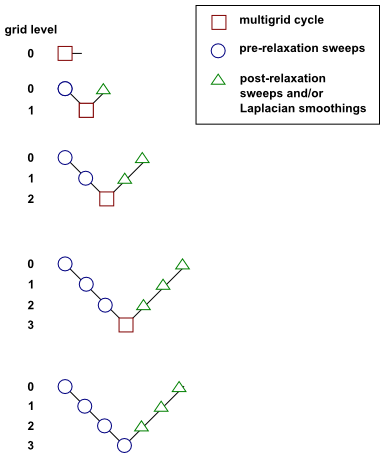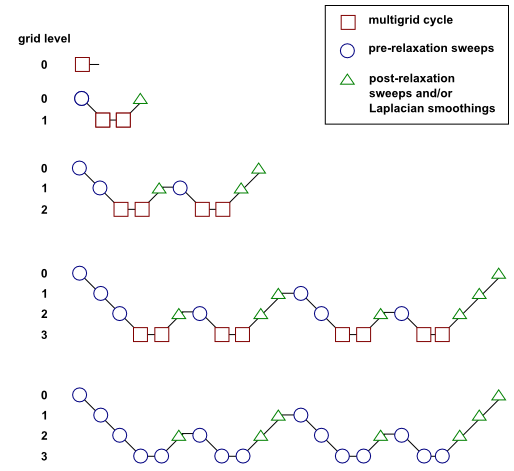A multigrid cycle can be defined as a recursive procedure that is applied at each grid level as it moves through the grid hierarchy. Four types of multigrid cycles are available in Ansys Fluent: the V, W, F, and flexible ("flex") cycles. The V and W cycles are available in both AMG and FAS, while the F and flexible cycles are restricted to the AMG method only. (The W and flexible AMG cycles are not available for solving the coupled equation set due to the amount of computation required.)
Figure 23.9: V-Cycle Multigrid and Figure 23.10: W-Cycle Multigrid show the V and W multigrid cycles (defined below). In each figure, the multigrid cycle is represented by a square, and then expanded recursively to show the individual steps that are performed within the cycle. The individual steps are represented by a circle, one or more squares, and a triangle, connected by lines: circle-square-triangle for a V cycle, or circle-square-square-triangle for a W cycle. The squares in this group expand again, into circle-square-triangle or circle-square-square-triangle, and so on. You may want to follow along in the figures as you read the steps below.
For the V and W cycles, the traversal of the hierarchy is governed
by three parameters, ,
, and
, as follows:
First, iterations are performed on the current grid level to reduce the high-frequency components of the error (local error). For AMG, one iteration consists of one forward and one backward Gauss-Seidel sweep. For FAS, one iteration consists of one pass of the multi-stage scheme (described in Explicit Formulation).
These iterations are referred to as pre-relaxation sweeps because they are performed before moving to the next coarser grid level. The number of pre-relaxation sweeps is specified by
.
In Figure 23.9: V-Cycle Multigrid and Figure 23.10: W-Cycle Multigrid this step is represented by a circle and marks the start of a multigrid cycle. The high-wave-number components of error should be reduced until the remaining error is expressible on the next coarser mesh without significant aliasing.
If this is the coarsest grid level, then the multigrid cycle on this level is complete. (In so the square representing the multigrid cycle on level 3 is equivalent to a circle, as shown in the final diagram in each figure.)
Important: In the AMG method, the default value of
is zero (that is, no pre-relaxation sweeps are performed).
Next, the problem is "restricted" to the next coarser grid level using Equation 23–121.
In Figure 23.9: V-Cycle Multigrid and Figure 23.10: W-Cycle Multigrid, the restriction from a finer grid level to a coarser grid level is designated by a downward-sloping line.
The error on the coarse grid is reduced by performing a specified number (
) of multigrid cycles (represented in Figure 23.9: V-Cycle Multigrid and Figure 23.10: W-Cycle Multigrid as squares). Commonly, for fixed multigrid strategies
is either 1 or 2, corresponding to V-cycle and W-cycle multigrid, respectively.
Next, the cumulative correction computed on the coarse grid is "interpolated" back to the fine grid using Equation 23–122 and added to the fine grid solution. In the FAS method, the corrections are additionally smoothed during this step using the Laplacian smoothing operator discussed in Implicit Residual Smoothing.
In Figure 23.9: V-Cycle Multigrid and Figure 23.10: W-Cycle Multigrid the prolongation is represented by an upward-sloping line.
The high-frequency error now present at the fine grid level is due to the prolongation procedure used to transfer the correction.
In the final step, iterations are performed on the fine grid to remove the high-frequency error introduced on the coarse grid by the multigrid cycles. These iterations are referred to as post-relaxation sweeps because they are performed after returning from the next coarser grid level. The number of post-relaxation sweeps is specified by
.
In Figure 23.9: V-Cycle Multigrid and Figure 23.10: W-Cycle Multigrid, this relaxation procedure is represented by a single triangle.
For AMG, the default value of
is 1.
Important: Note, however, that if you are using AMG with V-cycle to solve an energy equation with a solid conduction model presented with anisotropic or very high conductivity coefficient, there is a possibility of divergence with a default post-relaxation sweep of 1. In such cases you should increase the post-relaxation sweep (for example, to 2) in the AMG section for better convergence, or change the cycle type to F-cycle or W-cycle, with an under-relaxation factor set to 1. This is especially effective when calculating pure heat conduction or conjugate heat transfer. Any instability observed when using the F-cycle or W-cycle can be remedied by increasing the pre-relaxation sweep count to 1. Although the default value of 0 is optimal for most cases, increasing the pre-relaxation sweep value to 1 or 2 can improve convergence.
Since the default value for
is 0 (that is, pre-relaxation sweeps are not performed), this procedure is roughly equivalent to using the solution from the coarse level as the initial guess for the solution at the fine level.
For FAS, the default value of
is zero (that is, post-relaxation sweeps are not performed); post-relaxation sweeps are never performed at the end of the cycle for the finest grid level, regardless of the value of
. This is because for FAS, post-relaxation sweeps at the fine level are equivalent to pre-relaxation sweeps during the next cycle.




